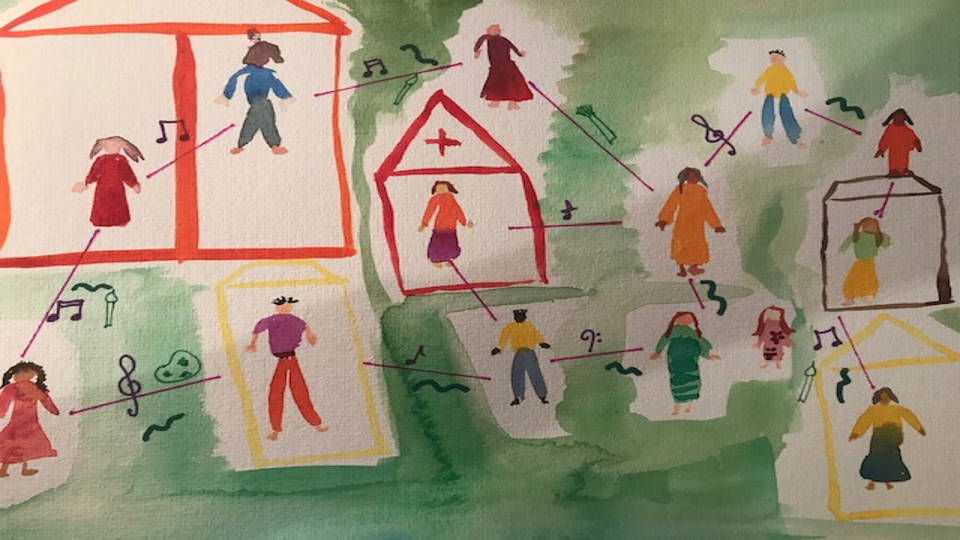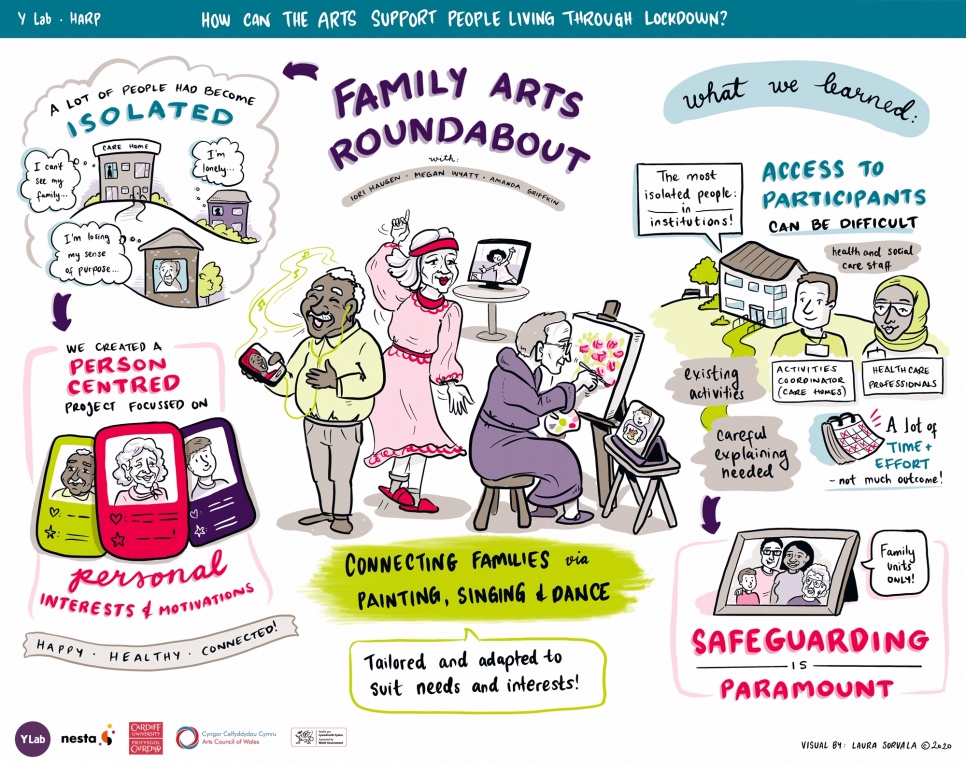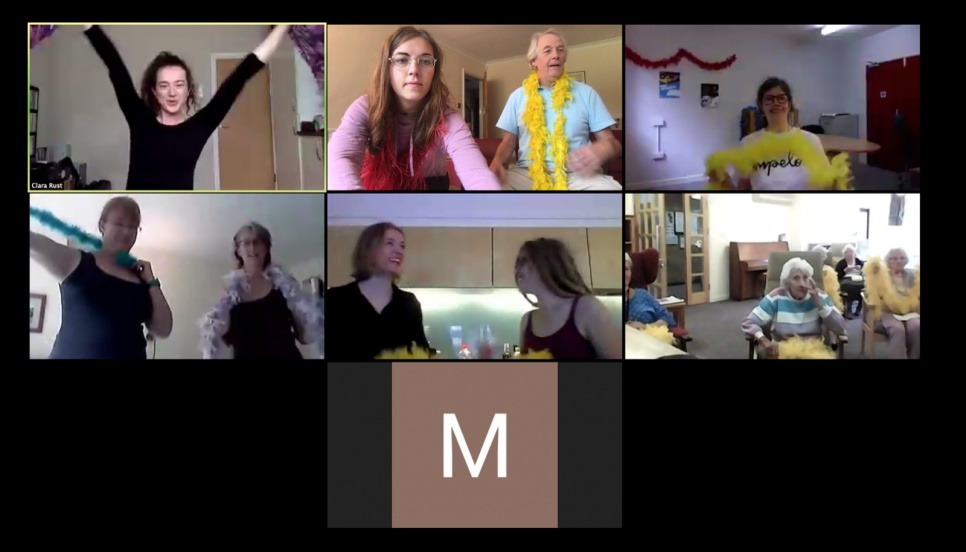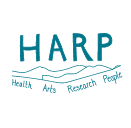Family Arts Roundabout
Iori Haugen, freelance musician, choir leader and music in health facilitator; Amanda Griffkin, artistic director, Impelo; and Dr Megan Wyatt, artist and visiting researcher, Wrexham Glyndwr University.
The aim: To support the families’ wellbeing and alleviate isolation by helping them to connect / communicate better online, overcoming generation gaps and technology barriers.
The activity: Supporting families where one family member is shielding, through an intergenerational arts project where the family works together online to create a joint piece of work centred on music, dance and visual art.

What need were you seeing in the world that motivated you to embark on the HARP Sprint challenge?
- We realised that there were a lot of people across a range of settings that had become isolated and were no longer able to see their friends and families and carry out usual daily tasks.
- People were at risk of losing their sense of purpose and becoming isolated and lonely.
- People were physically close together but completely isolated from one another or they were geographically divided
- There was a divide in ages ranges. Grandparents, grandchildren, schools
What did you want your contribution to be? What were your goals, hopes and dreams for your participants?
Happy - Healthy - Connected
We wanted to connect people creatively using the arts, to each use our own skills and experience to collaborate and create a really interesting and stimulating project that would connect young and elderly people together.
We wanted to give people the opportunity to experience new and exciting art forms with their families, by creating a bespoke and person centred project that is focussed around their own personal interests and ambitions.
What did you do and why?
We developed a visual, dance and singing project called ‘Family Arts Roundabout’: a dance professional, visual arts practitioner and a professional choir leader deliver a bespoke, enjoyable creative project to families who were not able to see each other physically during lockdown / social distancing.
We had spaces for three families to take part in a series of five online workshops over a four-week period, in painting, singing and dance. We worked with two families in the end; one was a geographically dispersed family where the eldest relative was a resident in a care home, the other was centred around a 16 year old who had recently received a bone marrow transplant and was shielding. The aim with each family was to produce something together, a video or a piece of artwork, all done remotely, to help them connect and communicate with their families by doing something fun and creative together. All activities were tailored and adapted to suit the needs and interests of each family, so they didn’t need to have any previous experience or interest in singing, dance or art to take part.

What did you learn?
This project was all about experimentation and learning, so we used this opportunity to try novel things we wouldn’t normally attempt. This included using different artforms with the same group of people, working remotely with the groups via Zoom, working in small intergenerational family units, through institutions and with people we did not previously know. We therefore aimed to learn about all these things, rather than seeking to devise a whole new way of working that could necessarily be scaled (as we knew early on that it would likely be cost prohibitive to do so).
Working through institutions with people we didn’t previously know
For access to participants we were very reliant on care home activities coordinators and healthcare professionals as we could not access participants directly. This was time consuming; we were not always their priority and it took longer than we’d expected some to get back to us even to say ‘no’. In our case we went to the most challenging places and looked for the most isolated people within institutions. They also had to engage their families and we were working with multiple art forms, so the project had the potential to come across as complex and needed some careful explaining to potential participants. We approached institutions one at a time, as we only had three spaces, but this slowed things down and if we did this again a more ‘scattergun’ approach might be helpful.
In the end, however, finding an engaged activities coordinator from Newton Court (Swansea based care home), and helpful staff on the Teenage Cancer Trust ward in Cardiff, made a huge difference not just to accessing participants initially, but also throughout the delivery; those people made a big contribution to the project. In the care home in particular, the activities coordinator was crucial as she was able to repeat instructions, control the technology and prompt the resident/s to take part. Indeed, the activities coordinator also invited other residents along to the dance session so there was a sense of wider engagement, even though the main focus was on the family.
Safeguarding is paramount and this is something that affected the progress of our project. To adhere to safe guarding regulations, we decided to do our project within family units but that also limited our target audience.
Working remotely via Zoom
The online setting worked well, and during lockdown it was a good way of achieving the goals we’d set for ourselves around supporting family connections and helping older people to feel more comfortable with technology. For some family members, this was their only connection with their grandmother in a virtual space - largely contact was otherwise routed through the resident’s son and on the telephone.
For the teenager we worked with, this allowed her to work on something creative with her sister via Zoom (which neither were previously that familiar with).
The mix of online and offline engagement was also important. Whilst the artist facilitator could be remote, in all three sessions (music, art and dance) with the care home resident, there needed to be someone in the room physically to support and supervise. This proved to be an effective way of working with care home residents.
We were particularly pleased that we were able to support the teenage participant, as she was unable to access all of the interventions provided by the Teenage Cancer Trust due to the nature of her illness.
Working with this participant required a slightly different approach however; she was perfectly fine with the technology and thus did not require supervision, however we needed to tailor certain parts of our intervention; instead of a group singing activity, for example, she preferred to have an individual singing lesson. Having the resources and flexibility to do this was crucial.

Working in small intergenerational family units
The sessions were largely joyful, flexible and followed the organic wishes and interests of the people involved. Rarely do we get the opportunity to work in such a bespoke way, or with one family at a time; the ‘one-to-many’ set up of most arts and health activities we run does not allow for this.
It was very rewarding to be able to take a highly bespoke, co-produced approach to the creative activities; with both families, they steered the activities a lot more than would normally happen in group settings - for example they were able to choose particular songs for us to arrange, sing and dance to, particular colours for dance accessories, topics for the art pieces, etc. This gave the participants and their families a lot of ownership over the project and because of the small numbers we could be more flexible.
For the care home resident we worked with, the project gave her and her family access to a group activity that enabled them to have a shared experience together, a focus and something to talk about. Indeed, we perceived that the songs and visual art inspired conversations and laughter about family memories and interests, which were more meaningful to them than just talking about day-to-day topics.

Using different artforms
We noticed that the visual art workshops were particularly effective at inspiring deeper conversations about interests and experiences. Whereas the singing and dance workshops were higher energy with more laughter, whilst also inspiring the participants to speak about memories.
From the dance perspective, we had planned a structure that allowed for the time and space for conversational diversions to happen. However, everyones’ focus during the activities was excellent, so instead the family had a good chat at the end of the session. In having two practitioners lead the dance session, we were able to always have someone to demo the ‘seated’ version of the activity, and participants were able to choose for themselves which version to do.
Running a choir activity required a little more leg work prior to the sessions than a traditional choir session might. Normally one might arrange a piece of music and then teach it in person, however in order to do this effectively online the song must be recorded (in several parts) as well as creating lyric sheets/score well in advance so that participants have time to download and print them off. During the session the person controlling Zoom has to be able to use the mute all button quite frequently so as to minimise delay, feedback and crosstalk. These are all pretty standard elements of a virtual choir. However, in addition to these, when working with the care home it was discovered that switching off all videos apart from one or two was required as well, in order to help focus the session and minimise distractions. Again, flexibility is hugely important as often the conversation would go on long (but lovely) tangents and finding ways to return to the focus of the session was sometimes challenging.
Having an initial discovery and introductory meeting with both families was crucial to the success of the project. We discovered that with the teenage participant for example, dancing was a clear favourite, therefore the focus of our intervention became all about the dance. Whereas with the other family and in the care home, the song was the initial focus, and became the catalyst for the other activities. Flexibility was the name of the game here again, allowing us to adapt accordingly and radically change what was initially planned became crucial to the success of the overall intervention - it’s important to note that this flexibility was very much by design, and the reason we wanted to work with such targeted and small groups. We understand that it would be difficult to upscale.
Where will the team go from here?
Megan: I would like to carry on working collaboratively with professionals from other disciplines. I will develop more remote arts projects now I know it’s possible.
Iori: I’ve been very inspired with everyone’s creative, articulate and progressive attitude during this process. I feel much more connected to those working within the arts and health sector in Wales, and I’m confident this has strengthened links across many organisations and individuals who are working towards similar goals. I hope to be given the opportunity to add value to my colleagues' projects in future, and hope that our work has helped to progress the Arts in Health agenda for Wales.
Amanda: I’ve taken the learning from the Sprint and Family Arts Roundabout and folded it into the planning for a digital dance project for people with dementia that began this month. I too have really enjoyed collaborating with professionals from other artforms - more of this please!
Financial details
The direct total cost of the Family Arts Roundabout was around £2,000, including artist facilitator costs and art packs for participants.
Iori, Megan and Impelo each received a grant from Y Lab of £1,000 each to participate in the HARP Sprint.
This was originally published on Y Lab’s website in this format.

